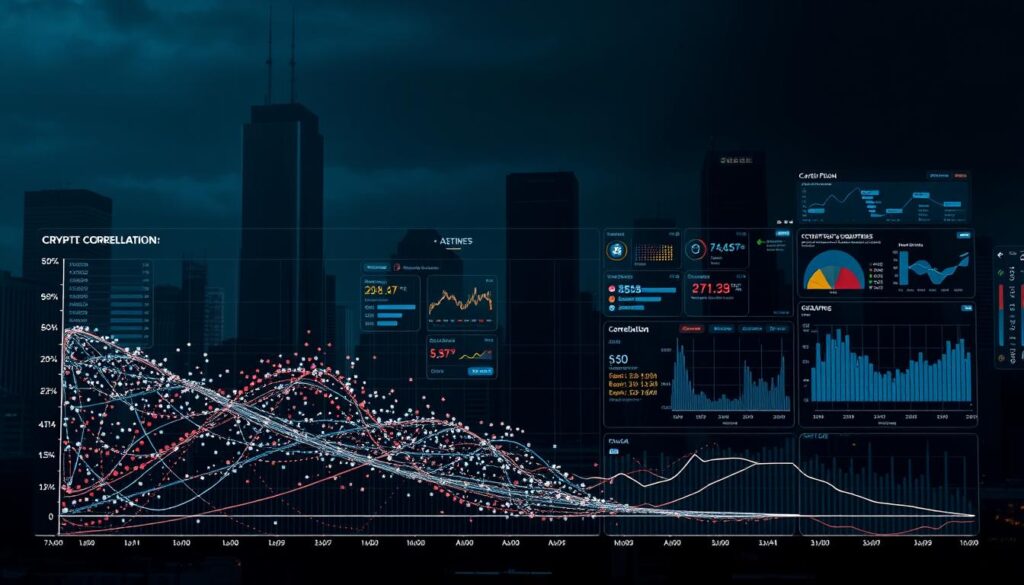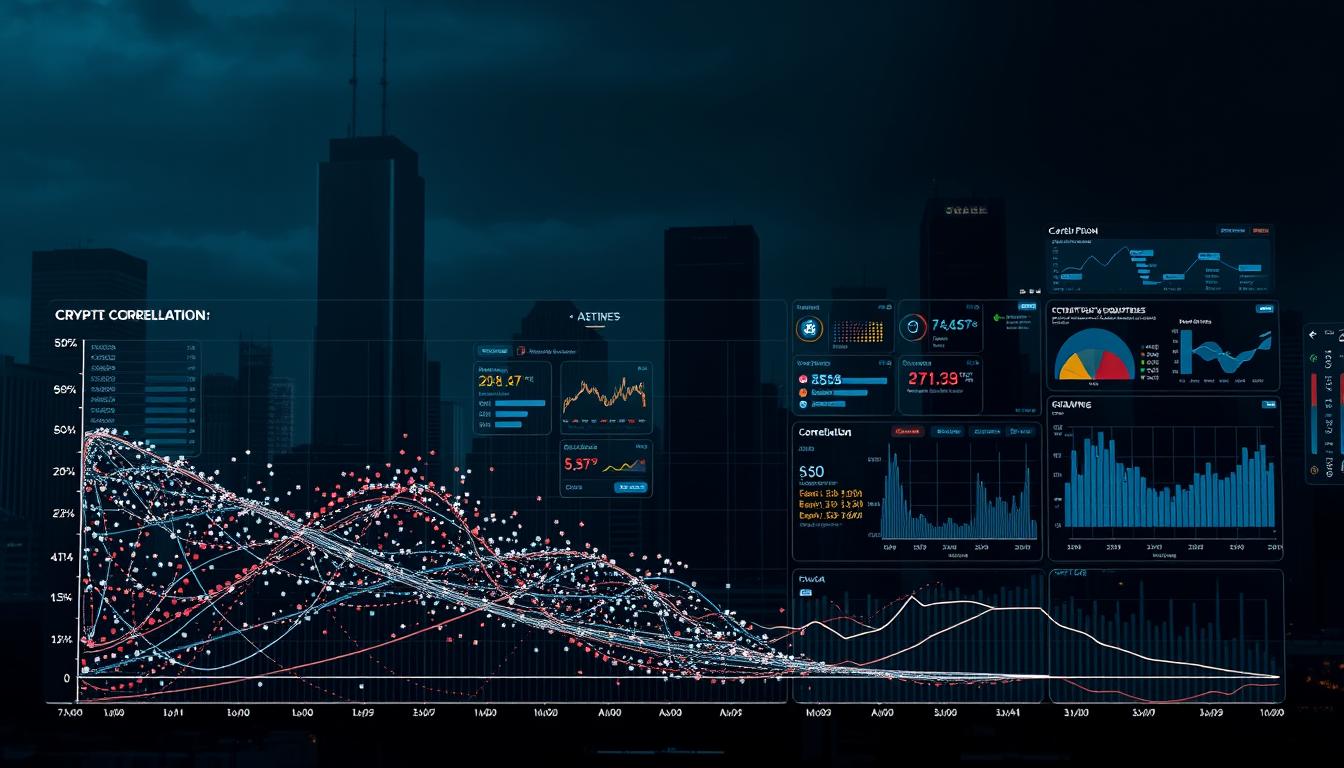Now Reading: Using Machine Learning Cryptocurrency Technical Analysis Indicators
- 01
Using Machine Learning Cryptocurrency Technical Analysis Indicators
Using Machine Learning Cryptocurrency Technical Analysis Indicators

This report explains how modern models use classic price signals to call buy and sell moves in the crypto market. It highlights reproducible pipelines, from data collection to feature selection and backtesting.
Recent studies show high classification accuracy for Bitcoin using MACD, RSI and Bollinger Bands, validated with confusion matrices and ROC curves. One framework achieved over 92% buy/sell signal accuracy, while other work using Random Forest on streaming Binance data reached about 86% in backtests.
The section frames when to use classification versus regression, and why simple feature sets often rival deep nets for intraday horizons. It notes practical choices: 15-minute intervals, 80/20 splits, chi-squared feature ranking (RSI30, MACD, MOM30, %D30, %K30), and attention to data leakage and transaction costs.
For a detailed survey and supporting results, see this review on reproducible methods and outcomes: research on crypto forecasting and evaluation.
Key Takeaways
- Indicator-driven models can improve direction calls when features are chosen carefully.
- Simple models with disciplined features often match deeper architectures for short horizons.
- Validate with confusion matrices, ROC curves, and realistic backtests that include costs.
- Use intraday intervals (e.g., 15 minutes) and proper train/test splits to avoid leakage.
- Focus on reproducibility: clear metrics, feature ranking, and transparent pipelines.
Executive summary of past findings and why they matter now
A concise review of prior work shows where strong claims hold up and where they fade under robust testing.
Key studies report mixed but instructive outcomes. Hafid et al. claim over 92% buy/sell accuracy on Bitcoin using RSI, MACD and Bollinger Bands, while a Random Forest approach on Binance streaming data reached about 86% in backtests. Cross-asset work by Jaquart et al. finds modest average directional accuracy (~53%-54%), but top-confidence deciles lift returns and long-short LSTM/GRU ensembles produced high Sharpe ratios after costs.
Other research highlights nuance. Liu et al. show stacked denoising autoencoders beating SVR and BPNN on error and direction metrics. Karam (2025) reports SVR and random forest beating deep nets when EMA and VWAP add noise without benefit. Roy et al. provide benchmark error figures for LSTM variants on historical Yahoo data.
The practical takeaway for U.S. traders: careful data handling, parsimonious features, and simple models often deliver the clearest path from statistical accuracy to tradable performance in today’s volatile market.
User intent and scope: how traders use technical analysis with machine learning
Traders often start with a simple question: which signals actually help predict short-term price moves? This section maps common search intent to practical scope and the limits of reproducible research.
Informational queries trend toward three themes: which technical indicators matter, how many to include, and how to convert those outputs into robust features for models.
- Users compare model classes (XGBoost, Random Forest, Logistic Regression, SVR, LSTM/GRU) by predictive performance, latency, and upkeep.
- They ask whether volume features like VWAP or Chaikin Money Flow add marginal edge versus pure price oscillators (RSI, MACD, Stochastic).
- Practical guidance centers on classification for direction or buy/sell signals and regression for price level forecasts, with horizon shaping label design.
This report focuses on past evidence: feature engineering, model selection, and evaluation practices that link predictions to tradable performance. It reviews confusion matrices, ROC, RMSE/MAE, Sharpe ratios, and backtests from surveyed studies.
What this does not cover: proprietary execution code, tax or legal advice, and live trading strategies. Instead, readers get a reproducible playbook for data needs, minimal stacks, and how to read reported metrics critically to judge real-world role and performance.
Market backdrop: volatility, liquidity, and data frequency in the cryptocurrency market
Volatility and venue liquidity shaped which time frames researchers used to model past Bitcoin moves.
Binance-based studies for Bitcoin used 15-minute bars from Feb 1, 2021 to Feb 1, 2022. Teams split this series 80/20 for train/test and reported results with confusion matrices, ROC curves, and out-of-sample backtests.
Why 15-minute bars captured prior price movements
Crypto trades 24/7 and liquidity varies by hour and venue. Fifteen-minute intervals smooth tick jitter yet keep intraday trends visible.
This interval reduced noise compared with tick-level data and kept signals responsive enough for short horizons. That balance improved perceived signal stability and tradeability.
Implications of high volatility for model selection and evaluation
- High volatility shifts class balance; threshold choices change measured accuracy.
- Smaller-cap assets show larger swings, so models need fewer strong features and robust regularization.
- Use stratified splits, walk-forward tests, and realistic backtests with spreads and slippage to judge performance.
| Item | Value | Split | Evaluation |
|---|---|---|---|
| Interval | 15-minute | 80% / 20% | Confusion matrix, ROC |
| Period | 2021-02-01 to 2022-02-01 | Walk-forward | Backtest with costs |
| Practical notes | 24/7 trading, variable liquidity | Regime-aware | Drawdown & stability |
Data foundations: historical data sources, sampling, and splits used in prior studies
Reliable historical feeds and careful sampling form the backbone of prior studies on short‑term price prediction. Good sources and clear splits determine whether reported signals are reproducible and tradable.
Primary sources included exchange-native feeds and public aggregators. Binance API streams supplied 15‑minute OHLCV for Bitcoin from 2021-02-01 to 2022-02-01 with an 80/20 temporal split. Yahoo Finance series (2016–2021) supported LSTM work that reported MAE 253.30, RMSE 409.41, and R² 0.9987.
Researchers used OHLC and volume to build features. Proper handling of time zones, daylight saving shifts, and missing bars avoids misalignment when joining multi-source series.
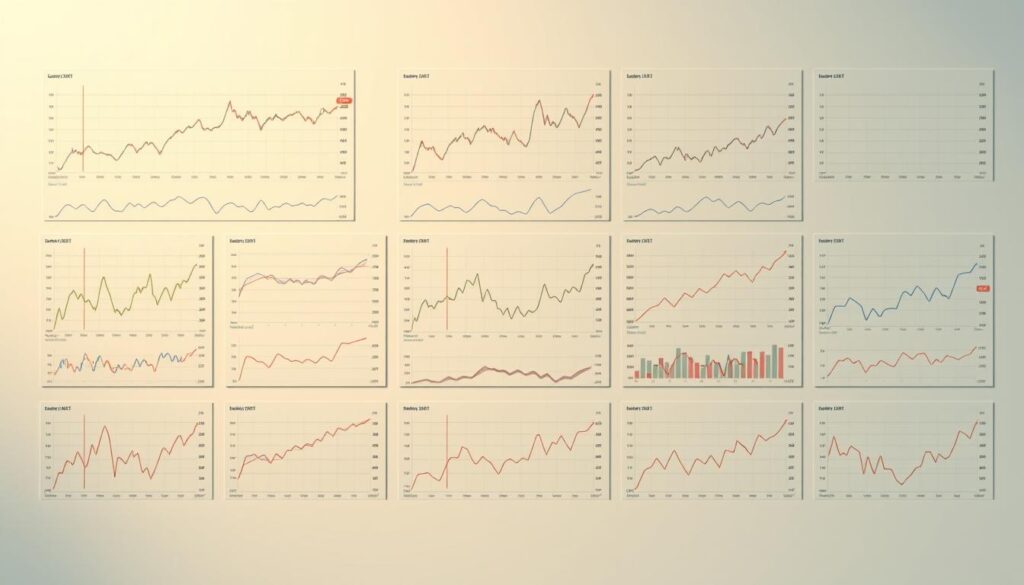
Train/test protocols and class balance
Common practice was an 80/20 split, though walk‑forward validation is more robust for a non‑stationary market. Balanced buy/sell labels make accuracy meaningful. When labels are skewed, teams report precision, recall, ROC, and PR curves instead.
- Preprocessing: fill or drop missing bars, clip outliers, and align indicator lookbacks to avoid lookahead.
- Volume: normalize or use relative volume to reduce exchange microstructure effects.
- Reproducibility: pin symbol mappings, calendar filters, and labeling rules so others can replicate results.
Finally, feature and target alignment must respect strict no‑peeking constraints. That step prevents leakage and gives honest estimates of model performance in live settings.
Technical indicators that shaped prior models
A focused roster of oscillators and volatility measures formed the foundation for many past forecasting efforts.
Core set: RSI, MACD, EMA, Momentum, Stochastic (%K/%D), CCI, Bollinger Bands, and ATR were the most common features across studies.
Core oscillators like RSI and MACD stay popular because they are easy to interpret and respond quickly to short price moves. Trend tools such as EMA and momentum capture direction and speed without adding opaque complexity.
Bollinger Bands and ATR add volatility context. When paired with momentum, they help refine entries and exits for intraday setups.
Volume-derived signals and practical notes
VWAP and Chaikin Money Flow appear in many papers to add traded volume context. VWAP frames price relative to the day’s flow, while Chaikin infers accumulation or distribution across candles.
When more is worse: multiple studies — including Karam (2025) — show that adding EMA or VWAP can complicate modeling without improving results. Simpler feature sets often let SVR or random forest outperform deep nets in backtests.
- Too many correlated signals can amplify noise rather than help prediction.
- Volume-derived measures may be exchange-specific; normalize before cross-venue use.
- Stress-test each feature for incremental predictive value across regimes.
Feature engineering and selection approaches that improved performance
Careful transformation and window choice turn raw price feeds into features that models can use reliably. Prior studies found that disciplined preprocessing and compact selection matter more than model size for many short horizons.
Transformations and lookback windows for time series features
Transform raw OHLCV into returns, z‑scores, and rolling stats using lookbacks that match the trading horizon. Studies using 15‑minute bars often computed 30‑ and 200‑period variants to capture short and regime trends.
Window size trades timeliness for noise. Matching input windows to forecast horizons helped stabilize signals in multiple past series.
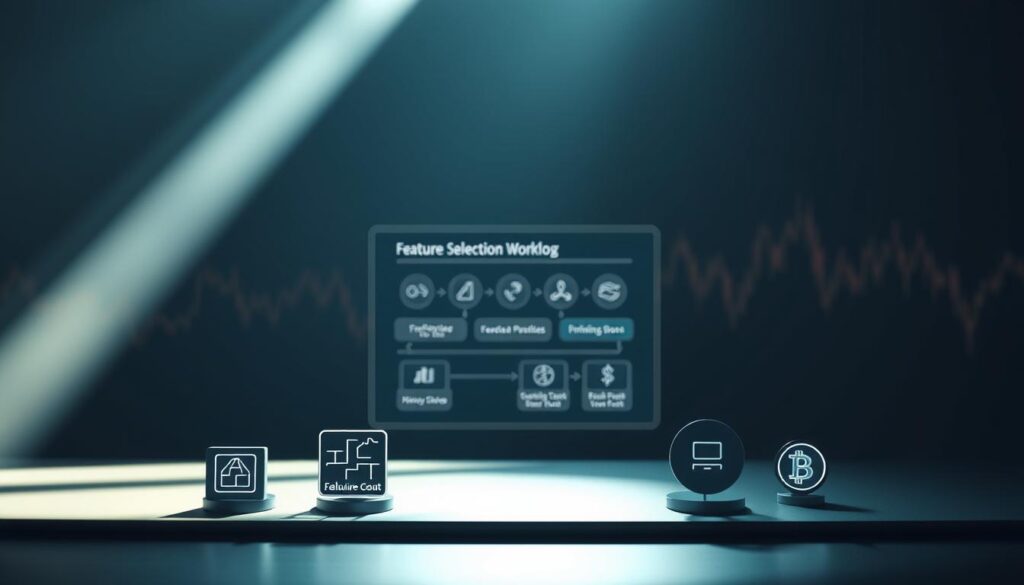
Chi‑squared selection and concentrated feature sets for robust classification
Researchers applied chi‑squared tests to rank candidate inputs and repeatedly retrained models with the top picks. Top contributors included RSI30, MACD, MOM30, %D30, %K30 and shorter RSI14 variants in one study.
Concentrated feature sets improved generalization for tree ensembles and linear baselines. Reducing correlated inputs cut overfitting and improved out‑of‑time returns.
Balancing dimensionality reduction with signal preservation
Dimensionality reduction should keep economic meaning. Use permutation tests and importance plots to confirm that retained features drive real lift.
Finally, enforce leakage‑safe rolling calculations, standardize inputs, and iterate selection with cross‑validation and out‑of‑sample checks. These steps yield more stable model behavior and clearer evaluation in practical data analysis.
Model landscape: from classical ML to deep learning
Trading research compares fast, explainable classifiers with deep sequence networks to see which approach holds up under real intraday noise.
Classification setups with tree and linear models
XGBoost, Random Forest, and Logistic Regression are common choices to turn engineered features into buy/sell signals. Studies benchmarked XGBoost and Logistic Regression on indicator-based inputs.
Random Forest classifiers reported up to 86% directional accuracy in backtests on exchange streaming data.
Regression versus sequence networks
Support vector regression (SVR) and Random Forest Regressor often compete with sequence networks such as LSTM, GRU, and vanilla RNNs for level forecasts.
Karam (2025) found SVR and RF regressors outperformed long short-term memory models when feature sets were concise.
When simpler approaches win
In many intraday tests, simpler learning models beat deep networks. Reasons include data volume limits, noisy price series, and the bias–variance trade-off.
- Tree ensembles handle nonlinear interactions without heavy scaling.
- Linear models give speed and interpretability for rapid iteration.
- Deep architectures can add value with richer inputs or longer contexts but need careful tuning and strict leakage controls.
Performance benchmarks from past research
Empirical benchmarks vary widely depending on asset, interval, and feature set. Focused Bitcoin studies reported the highest directional hits, while broader cross-asset tests show modest gains.
Directional accuracy and buy/sell signal precision differ by setup. Hafid et al. report buy/sell accuracy above 92% in a narrow Bitcoin classification study. Other teams using Random Forests reached about 86% in exchange backtests. Jaquart et al. found average accuracy near 53% with top-confidence deciles rising to about 58%.
Precision and recall change trade frequency and turnover. High confidence thresholds can cut trades but improve realized edge. Short horizons and order-book work show lower raw scores yet may still yield alpha when microstructure is modeled.
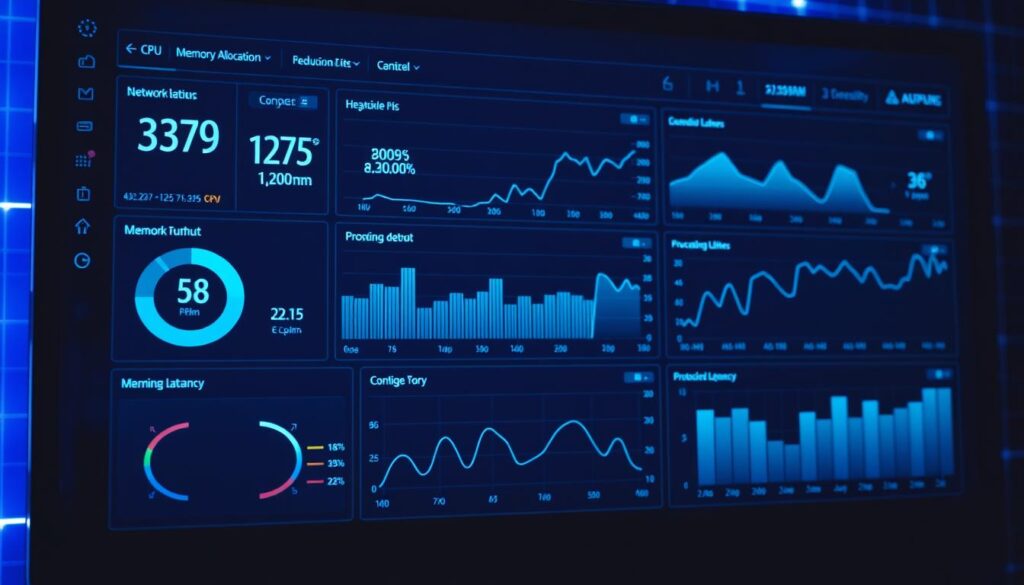
Error metrics and portfolio outcomes
Regression errors contextualize forecasts. Roy’s LSTM reported MAE 253.30 and RMSE 409.41 on price-level tasks. Liu’s stacked denoising autoencoder beat SVR and BPNN on MAPE, RMSE, and directional accuracy in their study.
Portfolio metrics give a fuller view. LSTM/GRU ensembles produced post-cost Sharpe ratios of 3.23 and 3.12 versus 1.33 for buy-and-hold in one paper. That shows how good prediction without realistic costs can still mislead.
| Metric | Example | Implication |
|---|---|---|
| Directional accuracy | 52.9%–92% | Wide spread; context matters |
| RMSE / MAE | 409.41 / 253.30 | Level forecasts need error context |
| Sharpe (post-costs) | 3.23 / 3.12 vs 1.33 | Ensembles can beat buy-and-hold if backtest rigorous |
- Backtest rigor—out-of-sample windows and realistic costs—determines tradability of reported edges.
- Rolling diagnostics reveal model drift across time and regimes.
- Benchmarks should be repeated with consistent intervals, assets, and feature sets for fair comparison.
machine learning cryptocurrency technical analysis indicators in action
Practitioners often find that a short, focused roster of signals gives the clearest edge on 15‑minute Bitcoin bars.
Chi‑squared selection repeatedly elevated RSI30, MACD, MOM30, %D30, %D200, %K200, %K30, and RSI14 as top features in past studies. Classification on 15‑minute bitcoin price series showed strong directional accuracy when these inputs were concentrated.
Top features and why they matter
Empirical rankings elevate RSI, MACD, and stochastic %K/%D variants as high‑signal inputs for intraday classification. Momentum windows like MOM30 capture short trend persistence that maps well to 15‑minute horizons.
How feature choice interacts with models and horizons
- Alignment: short lookbacks suit intraday labels; longer windows help daily direction calls.
- Model fit: tree ensembles exploit nonlinear mixes; linear baselines gain from interaction terms and regularization.
- Practical rule: start with the compact top‑8 feature set and expand only when out‑of‑sample gains justify it.
- Risk: too many correlated inputs raise collinearity and hurt generalization on short horizons.
Backtests show compact feature sets reduce turnover and improve stability, especially when transaction costs matter. For U.S. traders, disciplined feature selection often trumps chasing larger, more complex models.
Practical guidance for U.S. practitioners
Practical rules shorten the path from research papers to deployable U.S. trading workflows. Start with repeatable steps: pick a time frame, define features clearly, and test under realistic costs.

Selecting indicators and windows for intraday versus daily horizons
For intraday Bitcoin work, use 15-minute bars and a compact feature set. Favor RSI, MACD, stochastic variants, and short momentum windows. Expand only when out-of-sample gains are clear.
For daily forecasts, smooth inputs and use longer lookbacks to capture regime shifts. That reduces turnover and avoids noisy signals that hurt real-world performance.
Choosing between support vector / Random Forest and long short-term memory
When data is limited, prefer support vector or Random Forest models. Karam (2025) shows these often beat LSTM with concise features.
Consider long short-term memory only with abundant, well-engineered data, strong regularization, and careful hyperparameter tuning.
Evaluation design: balance checks, ROC, confusion matrices, and backtesting
Validation matters more than headline accuracy. Use walk-forward tests, check class balance, and report ROC plus confusion matrices. Include realistic transaction costs, slippage, and turnover limits for U.S. venues.
Document hyperparameters, feature definitions, and label logic. Monitor live drift and set retrain triggers tied to volatility regimes.
| Focus | Intraday (15m) | Daily | Evaluation |
|---|---|---|---|
| Typical features | RSI, MACD, %K/%D, MOM30 | EMA, Bollinger, ATR, longer MOM | ROC, confusion matrix, PR |
| Recommended models | SVR, Random Forest | SVR, ensembles, LSTM if ample data | Walk-forward + cost-aware backtest |
| Operational checks | Latency, turnover, capacity | Regime detection, lag | Calibration, drift monitoring |
Limitations, risks, and data pitfalls observed in prior work
Prior work exposes clear blind spots that can flip promising backtests into losing strategies. This section summarizes the key risks researchers and practitioners reported.
Overfitting, regime shifts and microstructure noise
Overfitting rises when many correlated signals feed short horizons. Regularization and strict feature selection limit this risk.
Distribution shifts across regimes can make a model trained on one series fail in the next. Drift detection and adaptive retraining help maintain performance.
Microstructure noise below 15‑minute bars flips labels. Smoothing and robust targets reduce this sensitivity.
Costs, slippage and data leakage
- Transaction costs and slippage often erase apparent edge in backtests.
- Data leakage from lookahead or shuffled time folds yields optimistic scores.
- Venue outages, gaps, and survivorship bias skew results without careful cleaning.
| Risk | Cause | Mitigation |
|---|---|---|
| Overfitting | High-dim features | Pruning, regularization |
| Regime shift | Market structure change | Drift detection, retrain |
| Leakage & costs | Lookahead, ignored fees | Walk-forward, cost-aware tests |
Where the research points next for crypto price forecasting
Where the research points next for crypto price forecasting.
Advances will come from architectures that respect multiple time scales while resisting regime drift. Future work should test compact feature sets alongside alternative data—on‑chain metrics, sentiment, and funding rates—to improve forecasting and price prediction in practice.
Robust training—walk‑forward tuning and domain augmentation—must be standard. Hybrid approaches that pair SVR/RF baselines with carefully regularized deep learning layers or neural networks can balance simplicity and sequence awareness.
Greater focus on execution, open benchmarks, and interpretability will help translate model gains into tradable outcomes for the U.S. cryptocurrency market. See a practical primer at AI cryptocurrency analysis.


